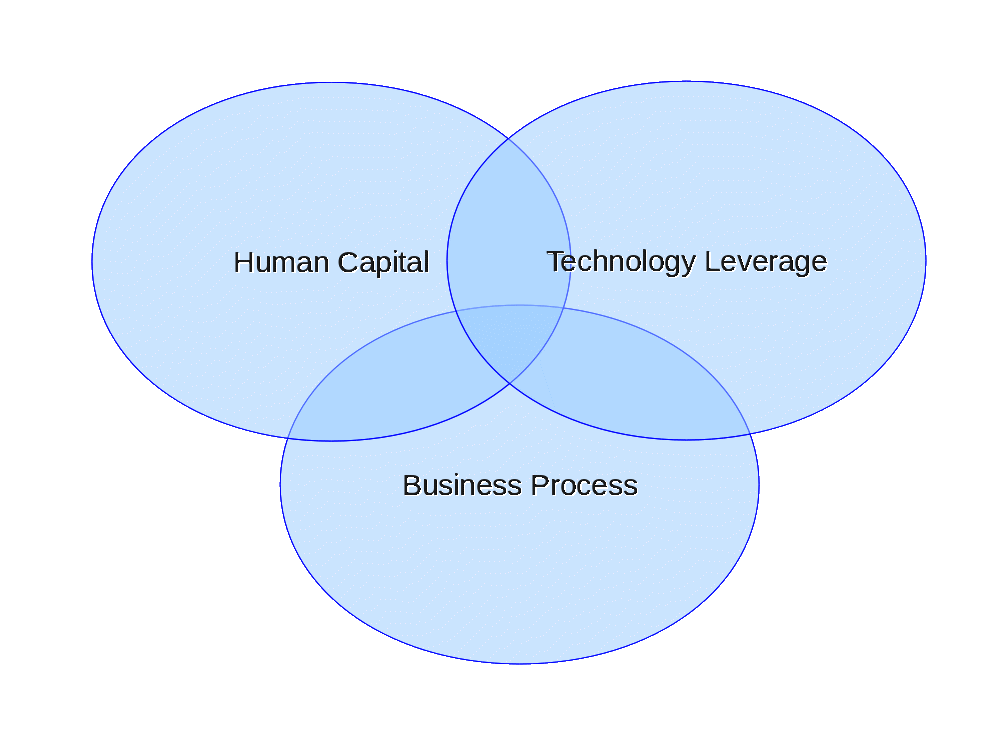Most people considering BPM based solutions will at some point consider a Center of Excellence – or CoE – as part of that strategy. While most tend to agree that CoEs establish some form of governance model and leverage past experience to improve future performance, the discussions around how this is done tend to diverge broadly.
Let’s focus on three of the more typical areas addressed by various forms of a BPM CoE: Business Process, Technology Management, and Staff / Sourcing Management.

While we segregate out the three focuses, the intent here is not to advocate focus in one area over all others but to highlight the differences in order to better determine the balance between these areas in defining the overall CoE strategy. Ideally, the CoE will sit in the center of these focus areas and facilitate a balanced consideration across them all.
Business Process Focus
Establishing the definition of the core business processes with their corresponding rules from scratch can be a daunting and time consuming task. Organizational intelligence must be mined, the history of the current processes analysed, and consensus must be established on the process, roles, responsibilities and success criteria to be targeted by these processes.
Once established, business processes must be continually evaluated on their fit against highly fluid business objectives. As flaws are identified in the process and exception handling is introduced, processes become more complex and intertwined until a re-engineering effort becomes necessary to meet targeted business performance metrics.
Business process centric CoEs will tend to focus on these types of challenges. Such a CoE is generally staffed with analysts and process consultants and will focus strongly on process methodologies like Six Sigma / Lean Six Sigma and drive optimizations against the business processes themselves.
Technology Management
A technology management focused CoE will focus on establishing best practices around management and deployment of the BPM solution platform.
Each BPMS solution has its’ own unique challenges in terms of deployment. Some require sophisticated supporting infrastructure and integration while others might offer more of a stand alone configuration. Consequently, tuning each environment requires a strategy and unique knowledge around each platform to manage initial configuration, promotion of releases, infrastructure sizing and resizing, and production load management.
Apart from general infrastructure management concerns, this type of CoE will focus effort on BPMS selection to map to the perceived technology needs of the business. To this end, key considerations may include how reuse can be maximized and provisioning for strategies and support around creation of framework capabilities to provide for baseline support in solving common business challenges across business verticals. Implementation of frameworks on the various flavors of BPMS suites varies in terms of complexity, level of effort, and degree of difficulty and intent to create framework like capabilities may be a deciding factor in BPMS selection.
The technology centric CoE plays an even larger role when disparate platforms are selected and standardization around a single BPMS is not possible. In such cases this CoE will play a crucial role in assisting to align the BPMS selection with the core underlying business needs.
Staff & Sourcing Management
Another functional area requiring foresight and planning is in how to prepare the workforce to implement BPM based solutions. Preparation might include training, recruitment, outsourcing, staff consolidation, or a myriad of other activities focused on establishing, developing, and managing the pool of human capital required to achieve success. Such management can include setting overall capacity / utilization targets by vendors to manage the contractual relationship with staffing partners or provision expertise internally as part of a shared pool of capability.
It’s not uncommon for a Staff & Sourcing CoE to further manage and continually evaluate the staff capabilities through the introduction of code reviews and process audits. In general, the bulk of such activities fall within the project teams but is facilitated by the central CoE group through process / review check-lists to ensure certain standards are applied to the execution of audits and reviews.
This type of CoE will also have a significant focus on knowledge sharing and management across the work force. Such knowledge focus will likely include catalogue management for the business process catalogue, knowledge source catalogues, standards and naming conventions, best practices definitions, how-to articles, and other vehicles for capturing and sharing knowledge gained through the experiences of teams across the enterprise.
